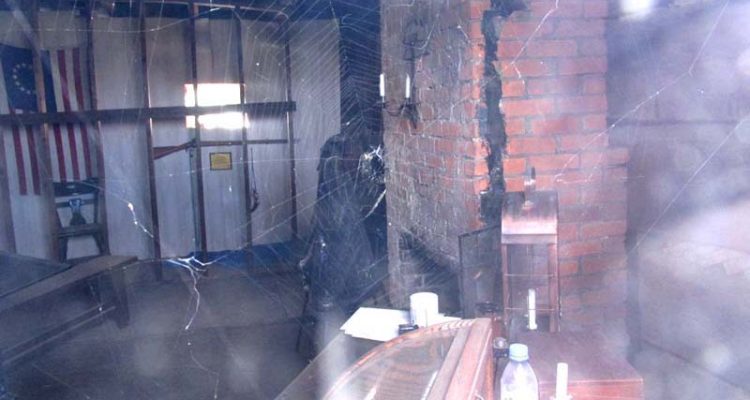Earl’s Note: This is a written version of the Fort Henry Speaker Series program presented on April 27, 2017. A video of that program is available online at this web site. The PowerPoint presentation and the courthouse photos from that presentation are available online at this web site.
From 1777 until 1797, the county seat for Ohio County was in West Liberty. This is the story of the events leading up to the formation of Ohio County and the county seat in West Liberty.
The first white person to settle in what is now the West Liberty area was Adam Black. Adam Black was a representative for Abraham VanMeter of Berkley County, VA. Black travelled west to this region in search of land which was available for free land grants. Black may have been accompanied by James Curtis. Some accounts have the two men coming west together and other accounts say that Curtis joined Black later. Curtis was an agent for Edward Morgan who was also from Berkley County and Curtis was also looking for land. Adam Black was impressed with the high “L” shaped ridge that WLU fans call the Hilltop. A great spring flowed from the southeast end of the ridge and the area was surrounded by rich farmland.
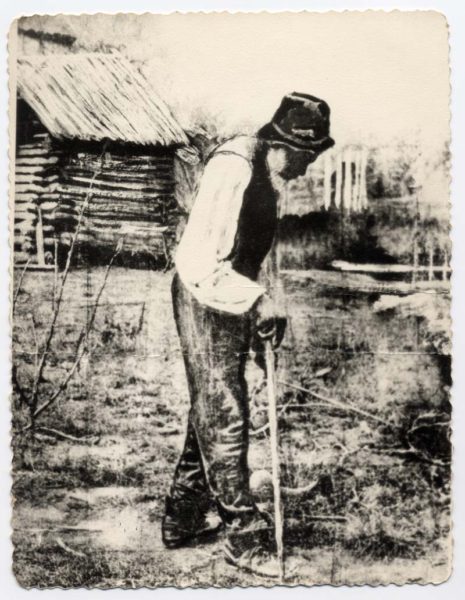
According to the back of the picture, this old man was a freed slave. Some men came looking for him and he hid out in an attic for several days. When he came out, his hair had turned white. The back of the picture calls this Black’s Cabin.
Adam Black marked out a 400 acre tomahawk claim for Abraham VanMeter which included the ridge and the spring. A tomahawk claim was made by using a hatchet or tomahawk to skin the bark off of the trees. Then, the initials of the claimant were carved into the tree trunk. Black built a cabin just above the spring. There are a number of drawings and pictures depicting Adam Black’s cabin with large squared logs. However, the cabin would have been made using fence post sized logs that Black could have lifted into place by himself or with the assistance of James Curtis. The old photo above has “Black’s Cabin” written on the back. Because of the size of the logs, the building in the picture could be Black’s cabin. The area became known as Black’s Cabin and the spring became known as “Wells Spring.”
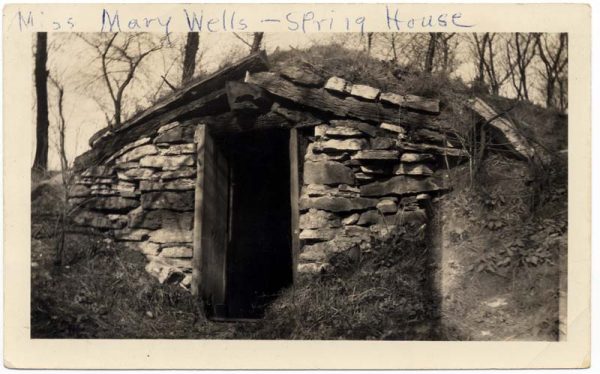
Back East, John Murray became the Royal Governor of Virginia around the same time that Adam Black arrived in West Liberty. John Murray was better known as the Viscount of Fincastle or the fourth Earl of Dunmore.
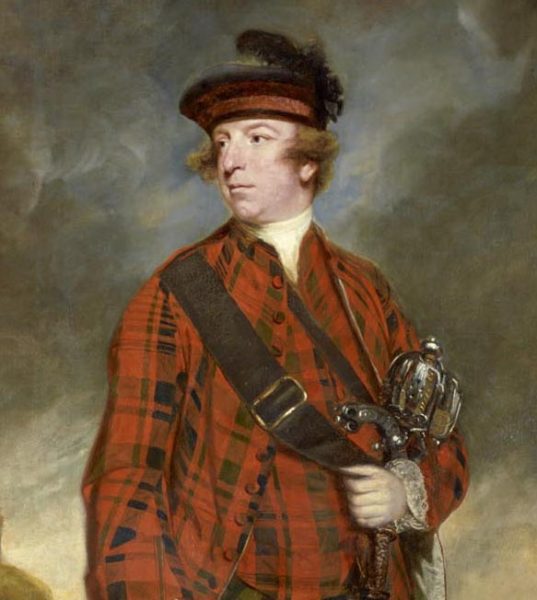
Governor Dunmore had an autocratic style of governing and did not convene the Virginia House of Burgess until 1773 when he wanted to expand Virginia by annexing a section of land to the northwest of Augusta County. Governor Dunmore declared that everything west of the Laurel Mountains extending to the Ohio River was part of Augusta County Virginia. He called the region “West Augusta.”
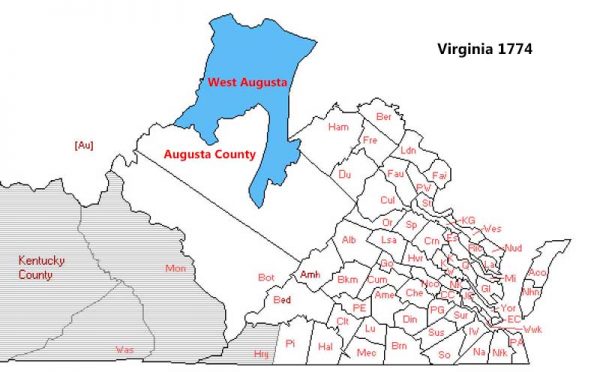
Kentucky County extended farther to the west. Fort Pitt and Pittsburgh were located in the dip at the top of West Augusta.
The House of Burgess went along with the claim in spite of the fact that a large portion of the region in question was also claimed by Pennsylvania. Governor Penn of Pennsylvania declared that a portion of the district of West Augusta was already part of Westmoreland County, Pennsylvania and ordered the arrest of anyone who tried to function as an agent of Virginia in that area.
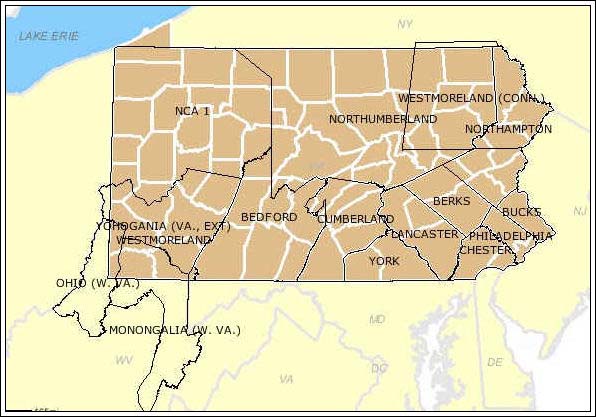
In January, Governor Dunmore appointed Dr. John Connolly to be the Commandant of the Militia in West Augusta and sent him to Pittsburgh to make sure that the residents of West Augusta knew that they were citizens of Augusta County Virginia. Connolly was instructed to post a declaration to that effect and to organize the militia in the region. He was also instructed to take possession of the old Fort Pitt to serve as a headquarters for the militia. Fort Pitt had been decommissioned by the British in 1772. The British sold the fort and all of the contents to Alexander Ross and William Thompson who were planning to deconstruct the fort and sell the wood and steel. Connolly and his militiamen (Thugs) took over the old fort on January 4, 1774. The historical accounts are vague regarding how Connolly obtained ownership of the fort. However, it is likely that he simply took it. Connolly renamed the fort as “Fort Dunmore.”
When Governor Penn of Pennsylvania learned of Connolly’s activities, he ordered Westmoreland County Magistrate, Arthur St. Claire to arrest Connolly. St. Claire arrested Connolly on January 24, 1774 and took him to the jail at Hannas Town which was the county seat for Westmoreland County. Hannas Town was located about thirty miles southeast of Pittsburgh. However, the Westmoreland County court was not scheduled to meet until April 8. Not wanting to feed and house a prisoner for three months, St. Claire released Connolly upon his word of honor that he would return and face the court on April 8. Connolly was a man of his word. He returned for court on April 8. However, he was accompanied by 80 heavily armed militiamen.
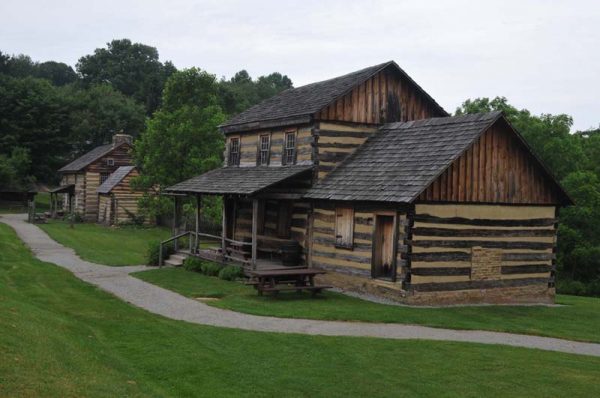
Hannas Town was a small community consisting of a few houses. The residents were alarmed by the sight of eighty armed men and so were the members of the court. Rather than risk a confrontation, the court dropped the matter and allowed Connolly to return to Pittsburgh. On the way back to Pittsburgh, Connolly and his men arrested three Westmoreland County court officials. Some of the old histories say that Connolly shipped the three court officials down the Ohio River to Fort Fincastle. (Later called Fort Henry) However, that is unlikely since Fort Fincastle was not built until June or July of 1774. During the next few years both Pennsylvania and Virginia arrested and jailed or fined officials from the other colony.
Early in 1775, Dunmore and Connolly moved the Augusta County court from Staunton to Fort Dunmore in Pittsburg. The first meeting of the Augusta County court at Fort Dunmore took place on February 21, 1775. John McCulloch, Silas Hedges, and David Shepherd were among the justices who were sworn in on that day. During the second day of court on February 22, 1775, Simon Girty swore the oath of allegiance to the crown. Other notable names mentioned during the 1775 sessions of the court at Fort Dunmore included Providence Mounts, Van Swearingen, Reason Virgin, and Sam Mason. Note: Van Swearingen fathered Betsy Zane’s out-of-wedlock baby and married Reason Virgin’s sister, Eleanor. For more information about that story read the Story of Betsy Zane on Weelunk. Van Swearingen was also Sam Brady’s father in law. For more information about that, visit this web page.
Back east, Patrick Henry and his militiamen were making life stressful for Governor Dunmore. Fearing for his safety, Governor Dunmore and his family fled from the governor’s Palace in Williamsburg on May 3, 1775.
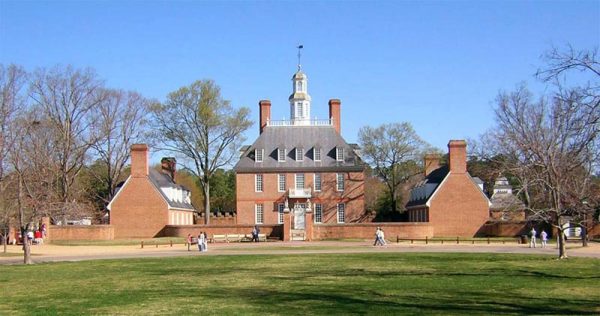
With Dunmore gone, Connolly soon had problems in Pittsburgh. He and his thugs had ruled the area with brutality. There are stories of them pulling down a family’s home because the man who lived there did not comply with Connolly’s demands. The community quickly turned against him and he was arrested. Exactly what happened next is unclear since the historical accounts do not all agree. However, the most likely scenario is that he was released provided that he would leave the Pittsburgh area. The other possibility is that he escaped and then left the Pittsburgh area.
Life in the portion of West Augusta that was claimed by both Virginia and Pennsylvania was difficult. Connolly and the officials from Augusta County Virginia expected the residents to pay taxes to Virginia and to serve in the Virginia militia and otherwise abide by Virginia Laws. Arthur St. Claire and the Westmoreland county officials had similar expectations for residents to abide by Westmoreland County and Pennsylvania laws and to pay taxes to Pennsylvania. There had been an underground discussion of independence for West Augusta. With Connolly gone, that discussion became more vocal. People were ready to declare independence from both Pennsylvania and Virginia and to establish a new colony of West Augusta.
On July 9, 1776, Patrick Henry became the new Governor of Virginia. He immediately put a call for representatives from around the colony to convene at Williamsburg to form the new Virginia Assembly which was to replace the old House of Burgess as the governing body for the colony. The Virginia Assembly met for the first time on October 7, 1776. The independence movement in West Augusta was known to Governor Henry and to the members of the Virginia Assembly. Losing the district of West Augusta would have resulted in the loss of all of the northern part of the Ohio River, so two actions were introduced into the Virginia Assembly on October 29, 1776. One was a resolution which made any discussion of independence in West Augusta a crime. The second was a bill which defined the boundaries of West Augusta and divided the district into three counties. The bill defined the boundaries of each of the three counties which were designated as Youghiogheny, Monongahela, and Ohio counties. The bill was read the second time on October 30 and was then passed by both the House and the Senate on November 1, 1776.
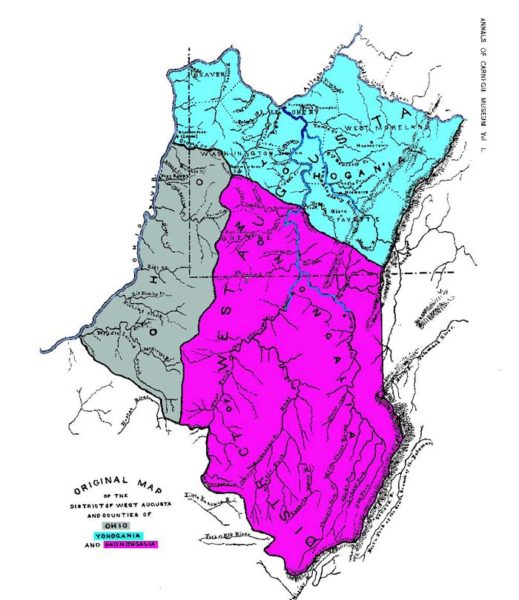
Ohio County bordered the Ohio River on the west. It extended from Cross Creek at the North to Middle Island Creek in the south. Cross Creek is located a couple of miles north of Wellsburg. Cross Creek Road is also called Bruin Drive because it leads to Brooke High School. Middle Island Creek enters the Ohio River at St. Mary’s, WV. At that time, Ohio County consisted of 1432 square miles compared to 109 square miles today.
Each of the three counties was to hold an election on December 8, 1776 to select representatives who would serve as members of a committee that would organize the county. Because that date fell on a Sunday, letters of protest were sent to Governor Henry and it is unclear if the election was held in Ohio County. Somehow, John McCullough ended up being in charge of setting up the organizational meeting for Ohio County. That organizational meeting was held on December 27, 1776 at the home of Ezekiel DeWitt on Buffalo Creek. It is interesting to note that the meeting was held two days after Christmas in the winter at the extreme northern end of the new county. After considerable discussion, the committee took a vote and selected Black’s Cabin as the first county seat for Ohio County. The committee also authorized Will Scott, James McMechen, & David Rodgers to administer the oath of office to the first court officials.
The new Ohio County Court met for the first time on January 6, 1777 at Black’s Cabin. The following was copied from the court record for that first day:
James McMechan there did on Monday the sixth of this Instant, did administer unto David Shepherd, Silas Hedges, Wm Scott & James Caldwell the oaths of Justice of the peace After being being duly qualified the aforesaid Shepherd did administer unto Messrs. Zachariah Sprigg, Thomas Waller & Daniel McClain the oath of Justice of the peace, who being duly qualified took their seats on the Bench accordingly.
John McCulloch, Esq. was sworn as high sheriff of said County, He then did offer Messrs. John Mitchel & Sam McCulloch, Both of this County, as sureties for the due executing the office of Sheriff within this County. The Court then proceeded to the choice of a Clerk, & James McMechen being approved of for that purpose & having taken the usual oath took his seat at the Clerk’s table accordingly.
The Court then adverting to the expediency that the Militia of this County should be under the best of Regulations and discipline, came to the following resolutions: that David Shepherd, Esq. be recommended to his honor the Governor as County Lieutenant in and for this County, & Silas Hedges as Colonel, & Mr. David McClure as Lieutenant Colonel, & Sam! McCulloch as Major of Militia.
Then, the court adjourned until the next day at which time it appointed several militia captains. This was copied from the January, 7, 1777 Ohio County Court record:
Furthermore it is ordered by the Court that Joseph Tomlinson, Sam Mason, Jn. Mitchel, Joseph Ogle, Sam Teter, David Williamson, Jacob Lefler, James Buchanen & Reasin Virgin be likewise recommended to his honor the Governor as Captains of the Militia.
On the same day, the court decided to purchase two acres of land from Abraham Vanmeter: Ordered that Zachariah Sprigg & Silas Hedges be appointed to Contract & Covenant with Abrham Vanmetre for not less than Two acres of said tract including the cabin & spring on behalf of this County, for the purpose of erecting & building thereon a Court house, Prison and other necessary public Buildings, for any sum not exceeding Twenty pounds. Although the order was issued, the two acres designated were not purchased and the courthouse and jail not built until the following year.
During the session held on April 8, 1777, the court approved the specifications for the new courthouse and jail:
The Court taking unto their Consideration the Expediency of having a Courthouse Erected, ordered that a house for that purpose be erected of the following Dimensions & Conveniences: a Diamond Cornered house of Dimensions Twenty Two by eighteen feet in the Clear ; one Story & one half high ; a floor above & below of hewd or sawn plank ; Ten Joists in the upper floor, nine or ten feet high ; in the Lower Story a Court’s Bench & Clerk’s Table : Two windows of eight lights each eight by ten Inches; a pair of stairs & Cabin Roof; a plain Door & hinges of Iron ; likewise plain window Shutters, with Iron hinges.
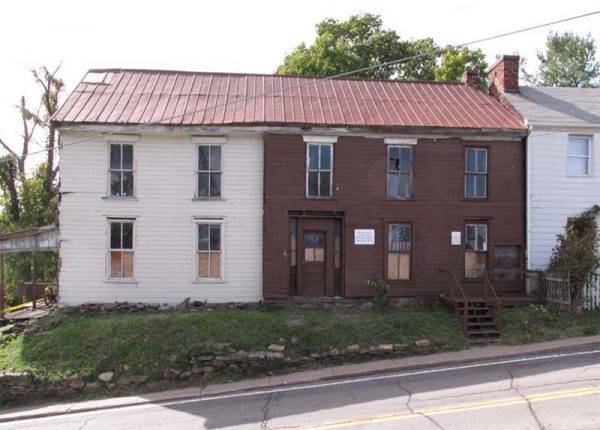
A jail twenty by sixteen feet on the outside, the Logs of the walls to be round & Close laid the loft ; floors & partitions to be of logs squared to eight inches thick ; Two Rounds of logs above the Loft; Cabin Roofed; Doors & windows agreeable ; A Stone Chimney with Iron Grates, the doors done with nails ; Lock Sufficient ; the Loft & floor to have each a Large Summur Supporting them in the middle.
This first court functioned as the county government in addition to the county court. Essentially, they were the first county commission in addition to the first county court. The final session of the court in 1777 was held on June 2. During that session of court, several militia officers presented letters of approval from the Governor and were sworn into their respective offices.
The next meeting of the court did not take place until April 6, 1778. Since John McCullough had passed away during the ten months that the court was out of session, the county was left without a Sheriff. The court appointed David Shepherd to be the new Sheriff. In addition, several additional militia officers were sworn in on that day.
The next day, George McCullough complained to the court that David Shepherd had overstepped his authority by commissioning some militia captains without consulting the court. This is from the court record for that day:
Upon the motion of George McCulloch to this Court, wherein he has Exhibited Certain Instances of David Shepherd having acted out of the Line of his office as Commanding Officer of the Militia by commissioning certain officers of Militia without the recommendation of this Court ; whereupon this Court has thought that information thereof be made to his excellency the Governor, praying that he may take cognizance thereof as to him shall seem meet Whereupon Colo. David Shepherd came into Court and produced sundry Commissions of Certain Gentlemen that he had Commissioned in the time of this Court’s Recess.
Fort Henry had been attacked by a large force of Indians during the fall of 1777. Expecting another attack at any time, Col. Shepherd had appointed captains for the militia companies which had no designated captains. The court understood the immediate need for those captains and approved them. No letter of complaint about that action was ever sent to Governor Henry. Instead, the court submitted the names of those who Shepherd had appointed for approval by the Governor.
By June, 1778, the courthouse and jail had still not been built. The delay was likely the result of the death of Sheriff John McCullough. During the June 2, 1778 session of court, this order was made: Ordered that David Shepherd, sheriff for this County, advertise to the lowest undertaker the Building of the public Buildings for this County, agreeable to the dimensions therein contained. (Courthouse & Jail) The courthouse and jail were built, but not on the site of Adam Black’s cabin. Instead, they were built across the road (Now Rt 88). The construction of the courthouse was completed in 1779. Sometime later, the court record shows an order to contact Abraham Vanmeter and pay him for the two acres that the county had taken to build the courthouse and jail.
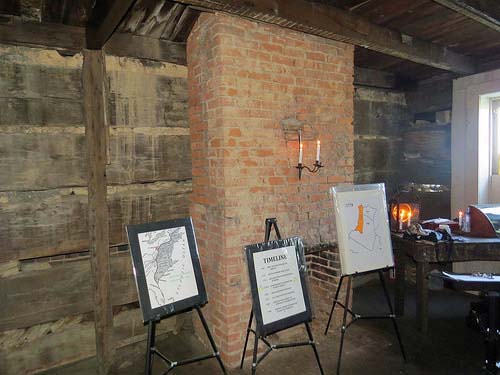
Court days in West Liberty brought large numbers of people into the area. The atmosphere was like that of a county fair or festival with plenty of food, drinks, games of chance and friendly competitions. For more about court days in west liberty, read the Weelunk item entitled Storytelling: Court Day in West Liberty.
The court records include mostly routine matters such as trying criminal cases, recording wills and appointing administrators for the estates of individuals who had passed away, settling disagreements between people, recording deeds, and assigning orphans to families to raise. The court also approved indentures wherein a boy was assigned to a tradesman until the age of 21 to learn his craft. The court recorded ear marks for identifying the owners of stolen or run-away livestock. Here is one example: Upon the motion of Benjamin Biggs ordered that his ear mark be an upper half-penny mark in the left ear and a slit in the right ear. A servant girl sued her master for being mean to her and asked that she be released from his service. Several days later, she returned to the court with the master and asked that the case be dropped. Another servant girl became pregnant and the illness resulting from her pregnancy made her unable to do her work. Her master sued the baby’s father for the loss of the services of the girl. The court ruled that the father-to-be be in the service of the servant girl’s master for a period of one year to make up for the loss of the girl’s labor. The court ordered the payment of stipends to several widows of men who died in service to the country.
The court legislated taxes on the citizens of the county. This is from the record of Ohio County Court Proceedings on August 4, 1778: Ordered that the sheriff Collect Twenty shillings & sixpence off of every Tithable within this County as a County Levy & the sum of Three shillings & six Pence as a proportion Levy, & Double that sum from all Who refuse to take the Oath of Allegiance, that is above sixteen years of age.
This is from the court record for September 7, 1778: Isaac Taylor entered into Bond and security to finish the Jail and court house for this county the court house by the 1st of March next, and the Prison by the 1st of May next; Ordered that the sheriff do advance Mr. Taylor the sum of fifty pounds and take Mr. Taylors receipt for the same. The construction of both courthouse and jail was completed in the spring of 1779.
During the period that the court met at Black’s cabin, it issued a number of individuals a license to operate an ordinary. An ordinary was a combination of a tavern, restaurant, hotel, and livery stable. Benjamin Biggs was one of the first Ordinary keepers in West Liberty. On Tuesday, June 6, 1780, the court set the rates for ordinary keepers as follows:
|
Rates for Ordinary Keepers ($=Shilling) Breakfast or supper, $4 Half pint of whiskey, $6 |
12 pence = 1 Shilling. 20 shillings = 1 pound
1 Shilling= about 10 cents US
Annual income of a substantial merchant around 100 pounds/year and more
Annual wage of a maid, 4 pounds, or less.
By the 1790’s, the county had grown to the point where it needed a larger courthouse and jail. The court authorized deputy sheriff Andrew Archibald and Isaac Meek to arrange for the construction of the new facilities. However, some irregularities in the sale of the old buildings and in the arrangement for Samuel Beck to construct the new buildings came to light. A lot of influential people in the county wanted the county seat moved to Wheeling which had become a more populous town than West Liberty. No doubt, the corruption related to building the new courthouse contributed to their success in having the county seat moved to Wheeling. The first meeting of the court in Wheeling was held on May 7, 1797 at an Inn owned by John Gooding. On June 5, the court, meeting in Wheeling, ordered that Archibald and Meek cease their activities and that the arrangement with Samuel Beck be voided. Archibald was ordered to come to court to face charges for his illegal activities. This order is from the June 5, 1797 court record: “Ordered that the commissioners who were appointed on behalf of the county to erect public buildings at West Liberty be authorized to cancel their agreement made with Samuel Beck, and that they do desist from further prosecuting said buildings until further order.”
The courthouse and jail along with the two acres of land were put up for sale. Captain Benjamin Biggs purchased the two acres and the buildings. He donated one acre to the Presbyterian Church for use as a cemetery. That acre was already in use as a cemetery since the oldest readable marker in the old West Liberty Cemetery today is that of Col. David McClure who died in 1786. Capt. Biggs’s son Zacchaeus Biggs converted the old courthouse building into a horse powered grist mill sometime around 1799-1800. In doing so, he sawed a large opening into the back (west side) of the building. Some historians speculate that the large opening was cut to facilitate unloading wagons. However, the first floor of the building is some six feet above ground level on the back side of the building, so it is likely that the opening was made to accommodate the drive system for the horse driven mechanism. Perhaps it was made for both purposes!
Today, one of the two acres is occupied by the old West Liberty Cemetery. A cemetery map and listing is available online by clicking this link. Information about General Benjamin Biggs is available online by clicking this link.
The old courthouse building still stands in West Liberty. It is located on Van Meter Way (AKA Rt. 88) Just south of the Town Hall and store. For a pictorial tour of the old courthouse building, click this link.


